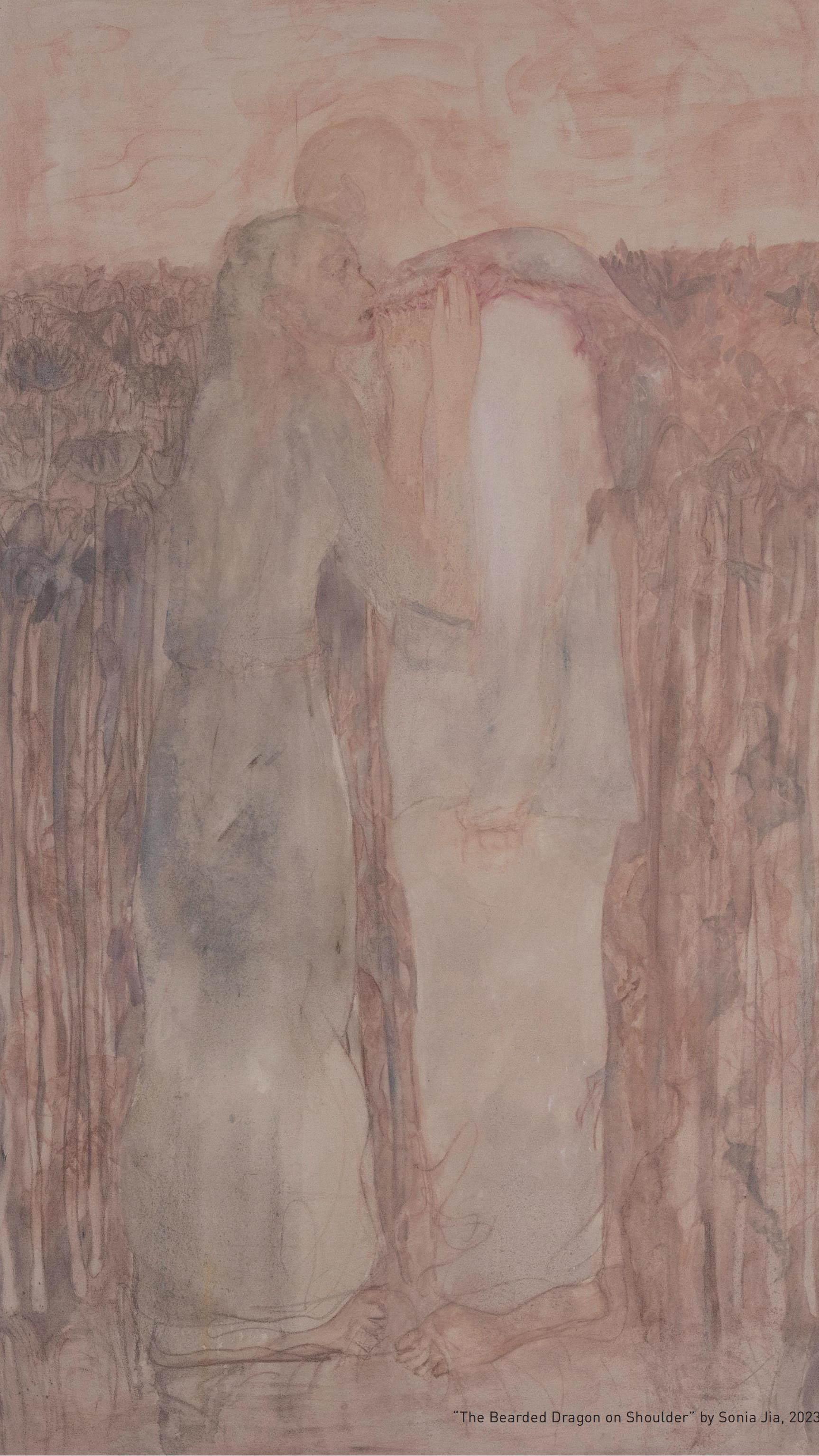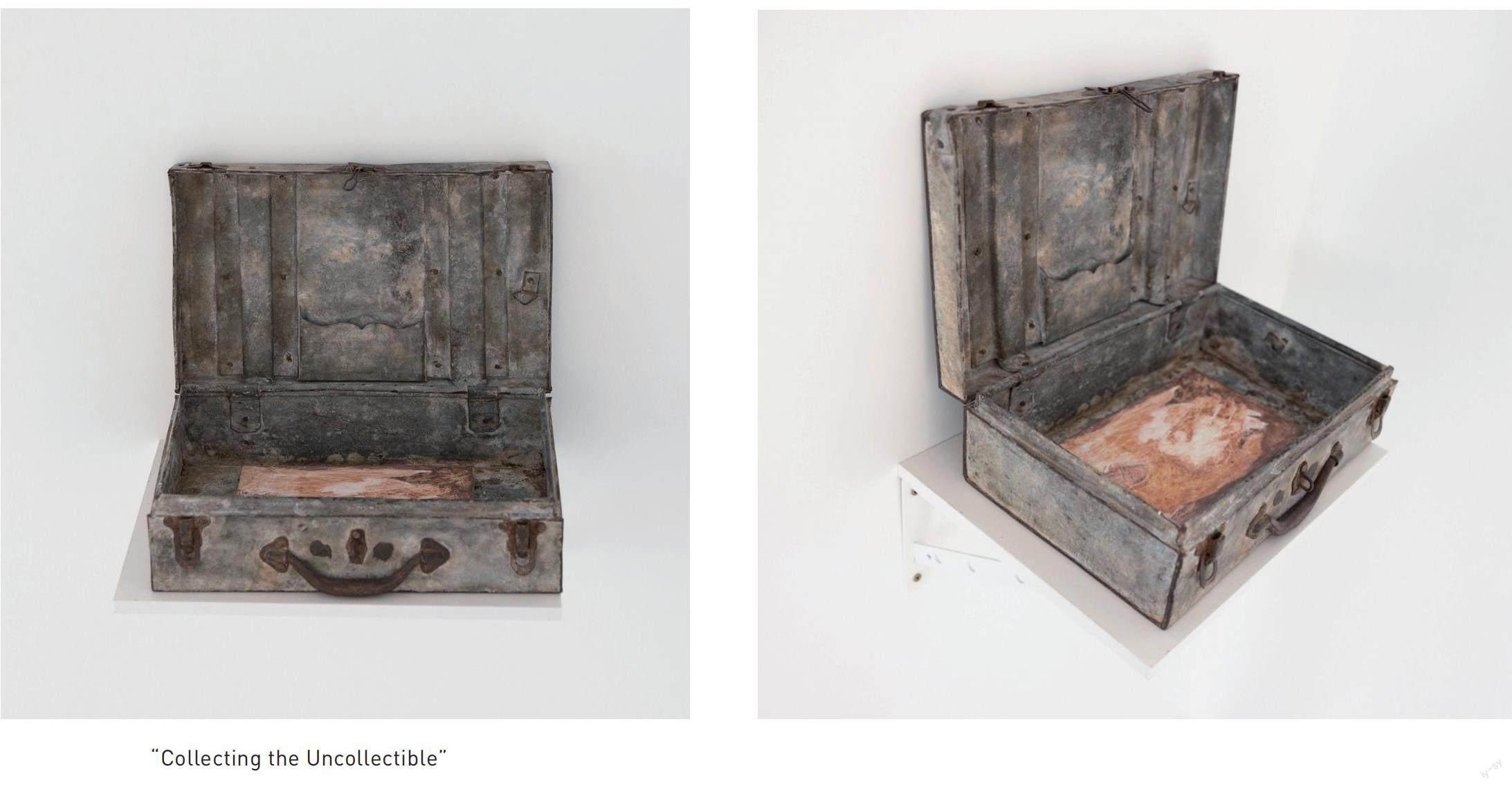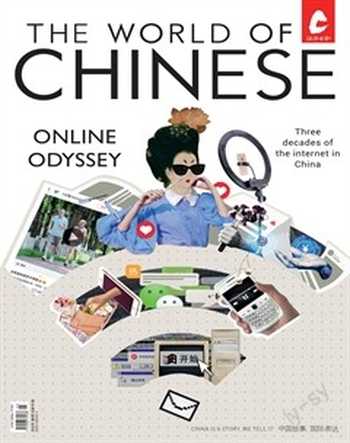艺术家夕背:画里的伤痛与疗愈
Hayley Zhao



Healing Strokes
A Gen Z artist explores trauma and the still-raw legacy of Japanese occupation on canvas
Images provided by Cubism Artspace
A bare maiden gets down on one knee. She offers a delicate bouquet to another woman who, in silent reverence, inclines her head to the flowers with a lit cigarette. Against a skin-colored backdrop, their unadorned bodies come to life, revealing the presence of scars and veins. The artwork resembles a fragment from an ancient cave painting.
Nearly all Sonia Jias recent paintings have this same palette of skin tones mixed with stormy mauve. The 23-year-old artist from Hangzhou, Zhejiang province, takes inspiration for her works from both her own past sufferings and the collective trauma of Chinese women during fraught moments of the 20th century.
Even though Jias career is just beginning, her work already hangs weightily on the walls of Cubism Artspace in Shanghai. When TWOC met her this October, she had just wrapped up a group exhibition at Cubism and was about to embark on her first solo exhibition in the same gallery a week later.
The exhibition, titled “Untouchable,” will explore the idea of precarious intimacy—the connection, care, and solidarity formed during perilous circumstances.
“I think in the formation of many intimate relationships, conflict will arise from personal trauma. But at the same time, our shared empathy toward trauma often blurs boundaries between people and allows us to form deeper bonds…Thats what makes the concept of precarious intimacy so captivating to me,” Jia tells TWOC.
Jias work has always been centered around the exploration of intimacy and vulnerability. Her artistic expression is part of her way of healing from the sexual trauma she experienced during her childhood.
Jia often finds solace from her past in books and films. She discoveredPrecarious Intimacies: The Politics of Touch in Contemporary Western European Cinemaby Maria Stehle and Beverly Weber, when she was pursuing her Masters degree in painting at Londons Royal College of Art. The book delves into films that explore tales of sexuality, love, and friendship against a backdrop of violence and exclusion, illustrating how political and economic changes can simultaneously restrict and enable fresh avenues for intimacy.
“[The book] broadened my understanding of the relationships between people and things in my own surroundings,” says Jia. She realized that harmful relationships brought about by perilous environments do not only exist in individuals. Throughout history, countless people have been afflicted by wars, and the relationships born out of those circumstances inspired many of the pieces in her solo exhibition.
As a child, Jia became familiar with Chinas tumultuous history in the early 20th century, marked by invasions and attempted colonization. Elderly members of her family often watched TV dramas about Japans invasion of China in the 1930s, and Jia later came across movies about the lives of “comfort women”—women and girls forced into sexual slavery by the Japanese army in occupied territories, such as the 2016 Korean movieSpirits Homecoming. Jia was fascinated by the bond formed between these girls and women and began researching the topic further.
She became haunted by the images and depictions of these women in Japanese military doctor Aso Tetsuos memoir,From Shanghai to Shanghai, which chronicles his experiences during his stationing in the occupied city from 1937 to 1941. The images also inspired Jias “Fading Bruise” series.
“The female students lying in the dark and desolate ruins, the boats transporting women, and the torn clothing...If youre not actively looking for or researching this kind of information, it might just disappear from the world, just like the initially painful bruises on our skin that will gradually fade away,” she says.
Referencing Asos photo of a ship transporting comfort women, Jia created the inaugural work in her series. From a distance, it appears as a searing, crimson wound encased within an antique plaster frame. However, upon closer inspection, the contours of a cargo ship materialize, unveiling a haunting narrative.
Other works in the series also draw on harrowing photographs captured amidst Japans invasion of China in the 1930s and 40s. From dead bodies resting in military trenches to captured rural women being transported to Japanese military camps, Jias canvases shroud the gruesome particulars within nebulous contours but convey emotional essence through her bold manipulation of color.
Rather than employing Western oil painting techniques, which use heavy layers, Jia embraces the delicate approach of Chinese landscape painting, covering the canvas with thin and translucent paints. The technique also signifies the artists attempt to seal the scars and bruises that are destined to fade with time within the canvas.
Jia has also ventured into filmmaking. In 2021, her short filmHer Feather, Her Body, a story about the psychological journey of a Chinese performance art student as she navigates through a same-sex relationship and childhood trauma, received awards at both the Paris Film Festival and the New York International Film Festival. Movies are a major source of inspiration for Jia—like in her painting “Tactile Fragment II,” where two women meld into an embrace, cradling an infant in their tender arms. The palette is a symphony of flesh tones dancing with hues of cyan, once again evoking bruises.
The scene is taken directly from a frame in director Zhang Yimous 2011 movieThe Flowers of War, set during the 1937 Nanjing Massacre when Japanese soldiers rampaged through Chinas then-capital for six weeks killing civilians and committing atrocities. Zhangs film, based on a novel by Yan Geling, tells the story of desperate schoolgirls and a group of flamboyant sex workers who both seek refugee from the carnage in a local church. When the Japanese order the schoolgirls to sing at their victory celebration, the sex workers selflessly switch places with them to protect their innocence.
The movie also inspired her oil painting “Fragments of Porcelain in the Haze of Battle,” where the intricate patterns echo theqipaodesigns worn by the female characters in the film. For the installation “Ci” (瓷, porcelain), which comprises scattered porcelain pieces laid on the ground, Jia intentionally framed it in a 16:9 ratio, mirroring the dimensions of a movie screen.
“We placed these artworks in the same area, with the intention of having them be an extension of each other. This is my tribute to the solidarity among women portrayed in the film,” Jia tells TWOC.
Although her subject and context can be full of uneasiness, Jia doesnt want her art to be interpreted as a product of pessimism but as a celebration of the unity that blooms from intimate relationships, much like how the skin rejuvenates from injury.
Despite just beginning her career (Jia only graduated from the Royal College of Art this July), Jia hopes to inspire audiences to reflect on conflict in a different way. “I also hope to explore, through my artwork, the connections between people in war beyond hatred,” she says.
“The Bearded Dragon on Shoulder” by Sonia Jia, 2023
Part of Jias “Ci” installation
“Collecting the Uncollectible”
“Kid”
“Before Leaving”
“Fading Bruise III”
“Fading Bruise IV”
“Light”

